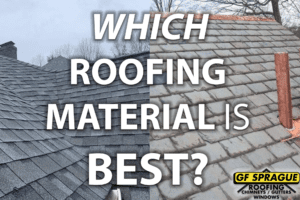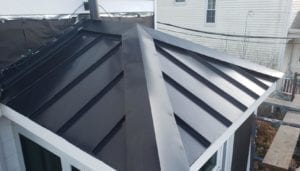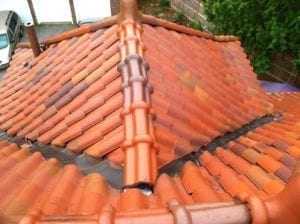Roofing materials are there to be selected for your roof replacement or repair. Whether your roof has been damaged or you’re wondering if it’s time to replace your roof, you are probably looking for the best quality roofing material to protect your home and family. Some things to take into consideration before investing in a roof replacement are your budget and the condition of your current roof. The roof is one of the most important home improvement repairs that a homeowner must face so doing the research and finding a trustworthy roofing company is vital. For this reason, we pulled together a list of commonly used roofing materials and their advantages and disadvantages. We hope this list will guide you in the right direction on the right roofing materials used in your roof repacement.
Slate Roofing Material:
As a traditional, natural roofing material, slate provides beauty, high fire resistance, versatility and strength. A slate roof increases your home’s aesthetic appeal and value and is unparalleled in design, longevity, and energy conservation. In fact, a slate roof can last as long as 75-150 years with proper maintenance. While it is one of the most expensive materials, slate offers long-lasting durability and is a wise investment, as well as being a selling point to your home’s future owners.
Advantages:
- Long-lasting
- Good for the environment and energy-efficient
- Aesthetically pleasing, especially with copperwork
Disadvantages:
- Expensive
- Requires professional installation

Asphalt Shingle Roofing Material
One of the most popular options for roofing material, asphalt shingles are found on more than 80% of homes. Their structure consists of fiberglass between asphalt and ceramic granules. The strength comes from the fiberglass, while the asphalt granules provide the waterproof benefits. Easy to install, asphalt shingles are the economical option. They last around 15-40 years, depending on the quality of asphalt shingles used and how well the roof is taken care of.
Advantages:
- Easy to install
- Inexpensive
- Comes in a variety of colors
- Repairs are easy and cost-effective
Disadvantages:
- Shorter lifespan compared to other materials
- Mold or algae growth in shaded areas
- Vulnerable to cupping and cracking

Wood Shingles/Shakes Roofing Material
Wood Shingles Roofing Material:
Wood shingle roofing material are made of thin pieces of wood, tapered and smooth on both surfaces. An attractive option, wood shingle roofs are long-lasting with an average lifespan of 25-30 years. Of the many wood options, cedar and redwood are the most commonly used types of wood in North American these days for roofing. Compared to asphalt shingles, wood shingles are trickier to install and require installation by a professional roofing company. In addition, because wood is a natural insulator, they are two times more energy efficient than asphalt shingles. If you live in an area where wildfires are frequent, wood shingle and shake use may be restricted.

Wood Shakes Roofing Material:
Compared to wood shingles, wood shake roofing material are hand cut from blocks of wood and are thicker and more expensive. They also stand up to weather and UV rays better than wood shingles. A wood shake is split to reveal the uneven natural grain of the wood on the face and is naturally beautiful and long lasting. They can last anywhere from 35-40 years but require proper maintenance. Keep an eye out for debris or moss because it needs to be removed immediately to ensure the longevity of the shakes.
Advantages:
- Natural beauty of wood
- Last longer than asphalt shingles
- 2x better insulation than asphalt shingles
- Enhance a multitude of architectural styles including, Cape, Bungalow, Tudor, and Victorian.
Disadvantages:
- Untreated wood has a class C fire rating and is risky if not properly treated
- Untreated wood shingles and shakes are high maintenance
- Repairs are expensive
Standing-Seam Metal Roofing Material
Another durable and eco-friendly option is standing-seam metal roofing material. This type of roof is constructed from large metal panels placed on the roof deck with the seams overlapping in raised ridges that run vertically down the roof. Of the metals, steel, aluminum, copper and zinc are often used. Copper is a popular choice for roof replacement because of it’s beautiful color that becomes an attractive green patina. It is resistant to extreme weather conditions and has a lifespan of around 30-50 years. Metal roofs are nearly maintenance-free but be sure to have a roofing professional check if the fasteners and seals on the ridges are secure.
Advantages:
- Durable and resistant to extreme weather conditions
- Low maintenance and long-lasting
- Very sleek and attractive depending on the metal
- Prevents ice dams
Disadvantages:
- Expensive
- Can be dented by fallen debris
- Without proper substrate between roof and living space, metal roofs can be noisier when rain hits
- Needs ice rails to prevent falling ice and snow
Tile Roofing Material
Similar to slate, a tile roofing material offers an attractive appeal with a long lifespan. While popular in the southwest, terracotta tiles can be found across the country due to their strength and durability. With proper maintenance, they can last 100 years or more. Not only are they immune to rot, moisture, and mold, but with proper installation, they can stay leak-free. Pricing for tiles may vary based on whether the tiles are traditional clay terracotta, fired ceramic, or concrete.
Advantages:
- Long-lasting and durable
- Attractive and distinct appearance
- Low maintenance and not vulnerable to rot and mold
Disadvantage:
- Heavy weight, requires a sturdy roofing structure
- Expensive
- Cannot be installed on a roof with a pitch of less than 4:12, over 5 is recommended
Now that you have finished your search for the right material for your roof replacement. Now your next step is to find the right roofing company and read what to expect from your roof replacement!




